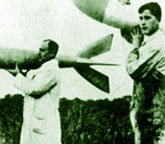 |
The booster is getting a little bigger and
heavier. Standing on its launcher. |
 |
Detail of the parachute arrangement. The
larger primary chute is deployed using
NOAA, and the
secondary is pulled out by the primary. You can
see the primary line passing behind the
secondary chute. |
 |
A deceptive photo, it doesn't quite reach
the ceiling. |
 |
Detail of the strapping tape reinforcing of
the bottle bases. This helps prevent distortion
of the base. |
 |
The business end of the rocket showing the
supporting brace. |
 |
Detail of the support brace and the rod that
fits into the trigger mechanism. The o-rings on
the 10mm nozzles are new. |
 |
Fins are held by large rubber bands made
from bicycle inner tube. Blue straps hold
bottles to central tube. |
 |
Top down view of the booster. |
 |
Detail of the launcher trigger mechanism,
nozzle seats and the filler tubes. Guide rails
are not fitted. |
 |
Pressure testing launcher and booster
segments, before the adapter rings are attached. |
 |
Top bottle caps bulging under the pressure. |
 |
Scale comparison using a standard size kid. |
 |
Detailed diagram of the Acceleron II rocket
explaining each of the different components. |















